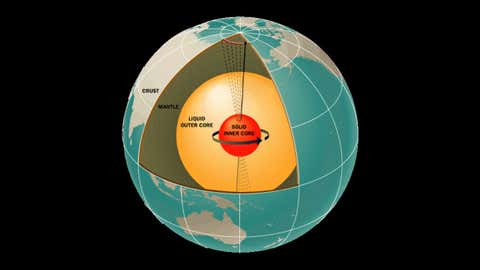
Deep within Earth's fiery heart, hidden behind layers of molten rock, a strange dance is taking place. Our planet's inner core, a solid ball of iron larger than Pluto, isn't just spinning — it's wobbling, like a top losing its balance, in a cycle that lasts nearly a decade.
While the Earth's gooey centre might make it seem less dense, this is hardly the case. Our iron-clad inner core, about 4-5 times as dense as our crust, is undoubtedly molten. But as the high temperatures convert the core's elements into semi-fluids, the immense pressure at the centre of the Earth also renders it into a pretty solid sphere.
As the Earth's core cools, grows and swirls, it releases heat, driving the churning liquid metal in the outer core. This creates what physicists term a 'dynamo' — a device that converts mechanical energy into electrical energy — that generates the characteristic magnetic field around the Earth, keeping us safe from terrifying solar weather.
Understanding the core's quirks is crucial, as even the slightest shifts can impact us on the surface. Interestingly enough, one of the reasons every day isn’t perfectly 24 hours long can be attributed to the minuscule variations caused by internal movements as well. In fact, recent research revealed the core itself changes its rotation direction every six years, which can have a notable influence over the length of a day.
The latest discovery builds on this knowledge, shedding light on the wobbly motion of Earth's poles. We've known about this complex dance for a while now, but in 2019, researchers noticed another distinct rhythm in the Earth's movements that seemed to occur roughly every 8.7 years.
Meticulously analysing both polar motion and changes in Earth's rotation, the team found something intriguing: the inner core's tilt and its slightly misaligned axis with the mantle were causing the wobble, which they calculated to occur every 8.5 years. The tilt, while a mere 0.17 degrees, was also a far cry from the massive 10-degree tilt previously assumed by some geodynamic models.
Moreover, the data suggested a sharper density change at the core-mantle boundary and potentially uneven density within the core itself. These factors, researchers believe, could influence the outer core's flow and ultimately shape Earth's magnetic field.
The Earth's core remains a mysterious realm, but the new study reveals another piece of its intricate puzzle. As our technology and understanding evolve, we can expect to witness even more fascinating dances in the heart of our planet, deepening our grasp of the hidden forces that shape our world.
The findings of this research have been published in Nature Communications and can be accessed here.
**
For weather, science, space, and COVID-19 updates on the go, download The Weather Channel App (on Android and iOS store). It's free!








